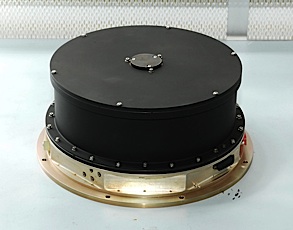Kepler is Sick and Resting: “Mountain View, we have a problem”
An update on the Siding Spring Observatory
January 13, 2013Kepler Planet-Hunter is Healthy and Back!
January 29, 2013“Mountain View, we have a problem…”
NASA Kepler Manager at NASA Ames, Mountain View announced today that they interrupted the science operation of the spacecraft, due an issue with one of the reaction wheels. Kepler is equipped with four reaction wheels which are used to accurately point the telescope. One failed in July 2012 and today the team announced that they detected issues with a second one. Kepler needs three reaction wheels to be used properly, if this one fails the mission is most likely over. That’s not good news.
The team detected an increase of friction on reaction wheel #4 on January 11 2013 just after the completion of Quarter 15 flight operation. This friction persisted after the spacecraft roll, which could lead to the complete failure of the wheel.
To solve this issue, the team reported to have placed the Kepler spacecraft in a “wheel rest” safe mode. Science operation has been interrupted and the spacecraft is now in a position which does not require the use of the reaction wheels. They hope that by resting the wheel for 10 days, the internal lubricant will be redistributed and the wheel will work again in an optimal manner.
The spacecraft was equipped with four reaction wheels, three of them are needed for the pointing of the telescope and the fourth one was installed as a backup. If this damaged wheel completely fails, the mission is over. In other words, the spacecraft will be unable to stabilize its pointing and the mission will stop fulfilling its scientific objectives.
Problems with reaction wheels seem quite common on spacecrafts recently. Dawn, another NASA mission designed to explore Vesta and Ceres, also lost two of his reaction wheels this year. Because this spacecraft does not need a pointing as accurate as Kepler, the problem was solved by developing a hybrid strategy relying on two reaction wheels and the thrusters of the probe. I have been told that a similar solution is unfortunately not possible for the Kepler spacecraft.
The Kepler mission has been approved for extension until 2016, providing four additional years to find Earth-sized exoplanet in the habitable zone of their stars. The mission therefore already completed its optimal operation time, so it is not surprising that engineering problems are now appearing. Outer space is not an easy place to be.
Last week, the mission team announced the discovery of 461 additional planet candidates, including two in the Habitable zone of their stars. The Kepler spacecraft is the most prolific planet-hunter so far, with a total number of 2,321 planet-candidates among 3,130 known exoplanets.
We discussed yesterday with Jon Jenkins the recent discoveries of Kepler. He mentioned the latent problem with those reaction wheels, so I am assuming that the entire team, including several SETI scientists, is anxious to know how Kepler will “feel” after this 10-day break.
Last week the French space agency, CNES, announced that COROT, another planet hunter spacecraft was also malfunctioning, and most likely will end the mission officially soon.
Are we witnessing the end of the pioneer planet hunters? I hope not, it is difficult to imagine a world of astronomy without Kepler.
Clear Skies
Franck M.





13 Comments
Next time, let’s have eight reaction wheels.
Good luck. I hope this does not mean the end of Kepler. Will think positive thoughts. 🙂
Nice blog Frank. Small typo: “on January 11 2913”. We are not that far off in the future!
Hope they’ll be able to revive the wheel!
corrected .thanks
¿Bromean? es increíble que precisamente la, rueda de seguridad sea la que falle!
[…] franck marchis blog Si te ha gustado el post compártelo :)TwitterFacebookRedditGoogle […]
Aw… I hope It’ll be fixed.
Hopefully problems will be resolved soon. Are the problems related to the outside temperature increases the viscousity of the lubricants for the wheels?
Titius – Bode law (Liesegang)
There is proposed a hypothesis according to which the regular structure of planetary systems can be explained as a consequence of spatially periodic condensation of gaseous matter during the formation of the Central Body.
According to the hypothesis, the periodic condensation on cosmic scales is analogous to the Liesegang phenomenon. Calculations indicate that the hypothesis is in agreement with certain facts: the mechanism of condensation under consideration does not contradict the basic laws of diffusion and s number of physical models:
http://creatacad.org/?id=21&lng=eng http://creatacad.org/?id=24&lng=eng
http://www.eso.org/public/archives/releases/sciencepapers/eso1035/eso1035.pdf
http://www.universetoday.com/87784/applying-the-titius-bode-rule-to-exoplanet-systems/
http://www.scielo.org.mx/pdf/rmaa/v47n1/v47n1a12.pdf
Now the Titius-Bode law sometimes helps to find new exoplanets!
Sincerely,
Georgi Gladyshev
[…] to Franck Marchis, a researcher at SETI, Kepler’s wheel failures are not unique. “Dawn, another NASA mission designed to explore Vesta and Ceres, also lost two of his reaction […]
[…] to Franck Marchis, a researcher at SETI, Kepler’s wheel failures are not unique. “Dawn, another NASA mission designed to explore Vesta and Ceres, also lost two of his reaction […]
[…] Marchis, Franck (17 January 2013). “Kepler is Sick and Resting: ‘Mountain View, we have a problem’”. Cosmic Diary. Retrieved 18 January […]
Post’s Link is Dead.
NASA’s Kepler Spacecraft Dead | elcidharth
May 15, 2013 at 8:18 pm
[…] Marchis, Franck (17 January 2013). “Kepler is Sick and Resting: ‘Mountain View, we have a problem’”. Cosmic Diary. Retrieved 18 January […]